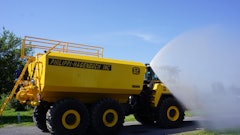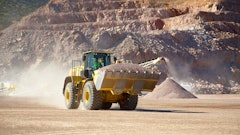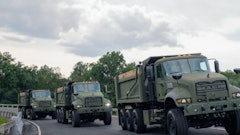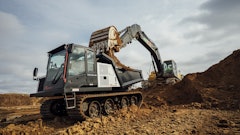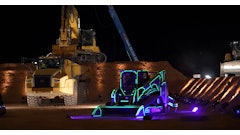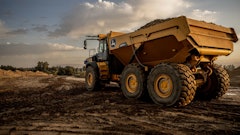Soft, wet underfoot conditions present a major hurdle for most rubber-tired haulers. Add in a tight work area and you have a challenge few vehicles can overcome.
This is where small articulated dump trucks (ADTs) and crawler carriers come in. Both are specifically designed for off-road applications, plus they offer the flexibility to maneuver in spaces too tight for larger machines.
Although these smaller, specialized vehicles can offer significant advantages in the right applications, their benefits should be weighed against the added cost and potential productivity reduction compared to more traditional haulers. Following is a look at when and where these vehicles can be your most cost-effective hauling alternative.
Short Cycle Times For Short Hauls
ADTs in the 14- to 25-ton-capacity range are suited for small to medium-sized projects requiring off-road capabilities. “Under the right conditions, small ADTs are more economically feasible than larger ADTs, taking into consideration the haul distance, size of the project, volume of material to be moved and conditions of the jobsite,” says David Morice, product manager at JCB Inc.
According to Tim Averkamp, product marketing manager, trucks and engines, John Deere Construction, the choice to use a small ADT is often a function of the type and size of loading equipment being used, as well as the allowable ground penetration at the site. For example, the overall dimensions of a smaller ADT tend to be a better match with small loading equipment. “If you use small wheel loaders (up to 4-yd. bucket capacity), or small excavators (e.g., 13- to 21-ton class), then definitely the loading height and smaller size body are better suited for more efficient cycles,” says Morice. “If you have a truck that you can load in half the time, you’re increasing your productivity and efficiency.”
On short hauls, this can equate to productivity close to that of a larger ADT. “Larger ADTs will still probably have a higher productivity than the smaller ones,” Morice states. “But in short hauls, we can get very close to the larger ADTs by nature of having much shorter cycle times.”
Smaller ADTs gain the upper hand, however, when it comes to tight work areas. “Confined jobsites make them more viable compared to larger ADTs or other haul vehicles,” says Morice. “They offer a much shorter turning radius.”
They also provide a lower overall weight and increased flotation well suited for turf-sensitive environments. “The smaller ADTs have been very successful in golf course development — either renovating golf courses or building new ones,” Morice notes. “The advantage there comes in matching the loading equipment and also because of the wide-profile tires.”
A six-wheel configuration (typically available on models above 20-ton capacity) and the low air pressure requirements of the high-flotation, oversize tires enable the tire to shape itself to the underlying surface, explains Averkamp. This allows for high traction with minimal ground disturbance.
An oscillation frame joint, hydraulic articulating steering and traction control devices further enable smaller ADTs to traverse conditions that can bring other rubber-tired trucks to a standstill. “ADTs are purpose-built, off-road, earthmoving machines that lend themselves to operation year round when other types of haul equipment may need to shut down,” says Averkamp. “Considering the broad range of applications and environments contractors face, quite often ADTs are the best choice compared to on-road trucks, scrapers and rigid-frame trucks.”
ADTs do tend to cost more to purchase than a comparably sized on-highway vehicle. However, Morice advises comparing costs per ton over the life of the vehicle. “Off-road articulated dump trucks will be faster because they have larger tires and the off-road capability,” he states. “When you equate it down to the cost per ton, even though it’s a higher cost of acquisition, they have a much higher productivity and utilization and the cost per ton comes out lower.”
“ADTs may not always be the best choice for every application,” adds Averkamp, “but in most cases, the ADT advantages will really shine.”
When Tires Just Won’t Do
Crawler carriers are essentially small dump trucks equipped with a crawler undercarriage. They come in capacities up to roughly 10 cu. yds.
These vehicles are not intended for your typical hauling applications. “If the application is dry, you’re going to use dump trucks if you can get them in there,” says Kendall Aldridge, national sales manager for IHI Compact Excavator Sales. “Our trucks are used in low ground pressure applications. It’s not really the same scenario.”
With ground pressure as low as 5 or 6 psi (loaded), crawler carriers are ideally suited for turf- or environmentally- sensitive applications such as golf course construction, trail building operations and pipeline installation in remote areas. Some models can also be adapted for applications beyond hauling.
“We probably experience about 60% used for hauling and the other 40% used for different applications,” says Aldridge. “The way our trucks are set up, we’re able to take the dump body or dump bed and cylinders off so you can put different attachments on them.” Available attachments include digger-derricks, personnel lifts and even fire fighting apparatus.
But the true niche for crawler carriers is in extremely wet underfoot conditions. “On the coastlines of the United States where they get a lot of storms, if it’s very, very wet, you’re talking about the job being down for two to three weeks,” says Aldridge. “With these moving and working all the time, at least you’re getting something done.”
Crawler carriers are a necessity for companies such as North State Environmental, Winston Salem, NC. Founded in 1994 by Darrell Westmoreland and his wife, Stephanie, North State is dedicated to repair and restoration of North Carolina’s urban and rural streams and rivers. This includes wetlands mitigation, erosion control, bioretention cell construction, bioengineering and reforestation.
North State’s equipment spends a lot of time working in soft underfoot conditions. “Everything needs to be a low ground pressure machine because we just sink in the mud,” says Westmoreland.
Prior to purchasing its 6-yd. Komatsu PC60 and 10-yd. PC110 crawler carriers, North State was often forced to use track loaders to move materials close to streams and wetlands. “The trucks would have to bring it to a staging area and the track loaders would carry it,”
Westmoreland explains. “Eventually, the track loaders would rut it up enough so that even they were getting stuck. Now we put it on the tracked trucks and they never get stuck.”
In addition to low ground pressure, the Komatsu crawler carriers offer 360° rotation. “We are working on steep banks a lot of the time,” says Westmoreland. “The 360° turn is nice because we’re able to turn the body to whatever direction we need to dump, rather than spin the entire machine on that type of incline.”
This also means less surface damage from rotating the tracks. “Vegetation is key,” says Westmoreland. “The less you tear up, the less you have to re-plant.”
The crawler carriers have proven easier on paved surfaces, as well. “We’ve found where we have pavement and parking lots, we can bring the rubber tracked trucks in,” says Westmoreland. “Because they distribute the weight, they are less likely to do damage than the dump trucks.”
Of course, there have been trade-offs to using these vehicles. “Compared to a traditional dump truck, the tracked truck is about three times as much to purchase to carry a third the amount of materials,” says Westmoreland. “But it will carry it, where the off-road trucks would be stuck and we’d spend hours digging them out.
“The efficiency,” he adds, “is that even though you have less capacity, at least you’re working. Otherwise, you wouldn’t be working at all.”

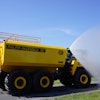

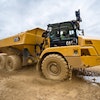
![Hcm Ax Landcros Dual Branded Logo[25]](https://img.forconstructionpros.com/mindful/acbm/workspaces/default/uploads/2025/11/hcmaxlandcros-dual-branded-logo25.Qhg3vUCjoK.jpg?ar=16%3A9&auto=format%2Ccompress&bg=fff&fill-color=fff&fit=fill&h=135&q=70&w=240)

